Brent Goose from Pöösaspea
Pöösaspean sepelhanhia
Suomi
English
Olimme Pöösaspeassa (Noarootsi, Läänemaa, Viro) katselemassa merilintumuuttoa 23-26.9.2011. Näimme suuren sepelhanhimuuton (yli 82000 lintua) ja etenkin kahtena ensimmäisenä päivänä iso osa linnuista muutti varsin läheltä. Tämä tarjosi mainioita tilaisuuksia katsella lintuja tarkemminkin. Määritimme seitsemän hrota - alalajin sepelhanhea (kaksi 23.9. ja viisi 24.9.). Kaksi näistä muuttivat yhdessä, muut toisistaan riippumatta erikseen parvissa. Määritykset ovat lähellä muuttaneista parvista, joten näistä luvuista ei voi suoraan laskea hrotan osuutta sepelhanhista.
We were at Pöösaspea (Noarootsi, Läänemaa, Estonia) watching seabird migration 23-26 September 2011. We saw a large migration of Brent Geese (over 82000 birds) and many of the birds passed quite close to us, especially during the two earlier days.This all made possible some closer looking at the birds. We identified seven individuals of subspecies hrota (two in 23 Sep and five 24 Sep). Two of these migrated together, the rest independent of each other in different flocks. All identified birds were from quite close flocks, so it is not possible using our numbers to count real percentage of hrota in the flocks passing NW Estonia in general.
Hrotan määrittäminen Itämerellä ei ole aivan niin yksinkertaista kuin lintukirjan kuvista voisi kuvitella. Monet nuoret bernicla-alalajin linnut ovat haaleampia ja vaaleampia kuin aikuiset ja saattavat näyttää erehdyttäviltä (ja nuoret hrotat ovat usein tuntuvasti tummempia kuin aikuiset, mutta se ei tässä yhteydessä ole käytännön ongelma). Myös aikuisissa on jonkin verran vaihtelua, ja vaaleimmat niistä saattavat erota porukasta silmiinpistävästi. Toisaalta varmaan risteymiäkin joukossa on, sillä tuskin nuo joka kevät bernicla-parvissa pesimäalueille muuttavat linnut pelkästään huviretkellä ovat. Kaikkein suurin ongelma on kuitenkin valo, joka vaikuttaa suuresti sepelhanhen väriin. Parvesta selvästi erottuva hrota katoaakin yhtäkkiä joukkoon, kun parvi kääntyy toiseen asentoon ja valo tulee eri kulmasta. Auringossa kaikkien hanhien vatsat näyttävät vaaleammilta ja rinnan väriraja monesti varsin selvältä. Oikea kunnon hrota on kuitenkin suhteellisen helppo erottaa parvesta, kun sen vain näkee riittävän läheltä ja riittävän pitkän aikaa. Vatsa on laajalti valkea, melkein valkoposkihanhimainen, ja sekaparvessa ero berniclaan näkyy itse asiassa jo varsin kauas otollisissa olosuhteissa.
The identification of hrota in Baltic Sea is not always as simple as it seems to be in the illustrations of bird books. Many young of the nominate bernicla are paler-looking than adults and may look confusing (and young hrota may be darker than adults, but it is seldom a practical problem in Baltic migration). There is some variation in adults too, and the palest of them may be quite distinctive in the flocks of more average individuals. In addition, most probably there are some hybrids too, because those single hrotas migrating to the breeding areas of bernicla in every year are not probably only watching scenery. However, the biggest problem is the varying light conditions, which have a great impact on the colours of the Brent Geese. Very distinct hrota in a flock suddendly disappears when the flock changes it direction and the angle of sun changes. In direct sunlight, the bellies of all geese look paler and the colour border on breast quite distinct. Still, a real hrota is relatively easy to pick from the flock, provided it is close enough and the observation time is not too short. The belly is widely whitish, almost like in Barnacle Goose, and in mixed flocks the difference to bernicla is visible even from quite large distances.
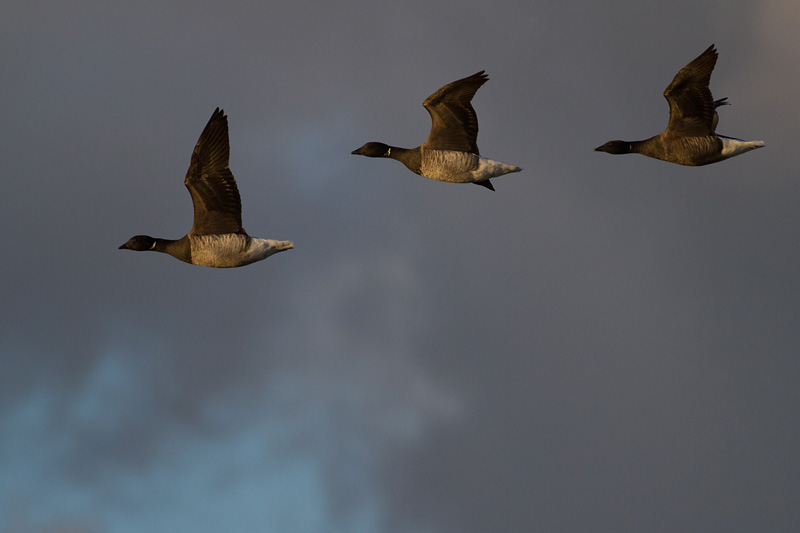
(1.) Kaksi yhdessä muuttavaa hrotaa 24.9.2011. Tässä tilanteessa ero näyttää hyvin selvältä.
(1.) Two hrota flying together 24 September 2011. In this photo, the difference looks very distinct.
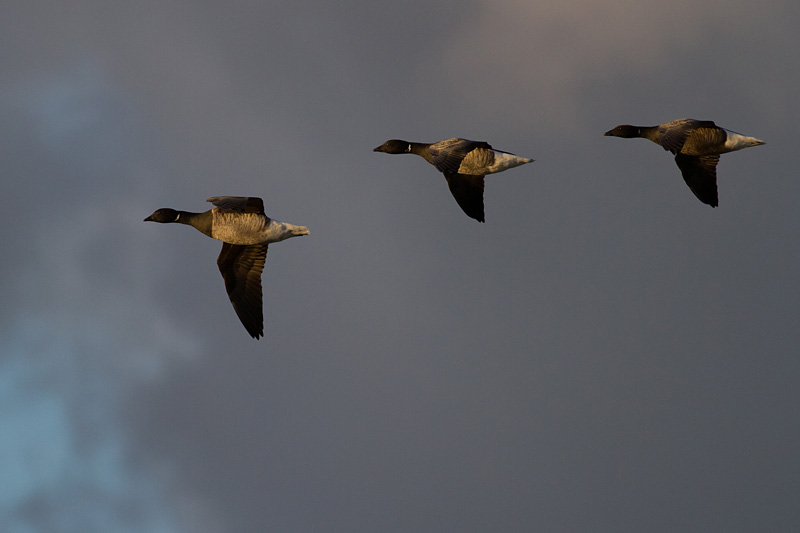
(2.) Samat kaksi. Joskus hrota näyttää päältäkin hieman vaaleammalta.
(2.) The same two birds. Sometimes, hrota shows palish upperparts too.
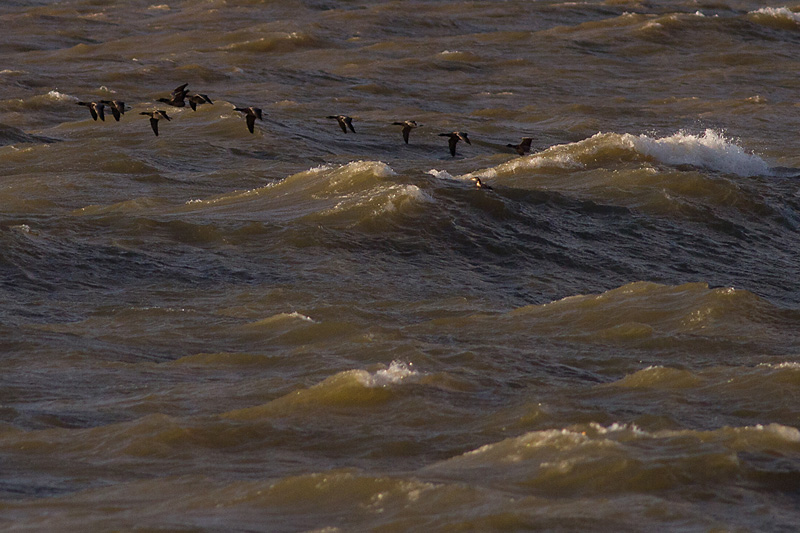
(3.) Tämä yksilö muutti pienessä parvessa 23.9.2011. Kuvassa hrota erottuu varsin räikeästi (kuten erottui maastossakin tässä tilanteessa).
(3.) This individual flew past in a small flock 23 September 2011. In this picture, the hrota is eyecatching (as it was in this situation in the field).
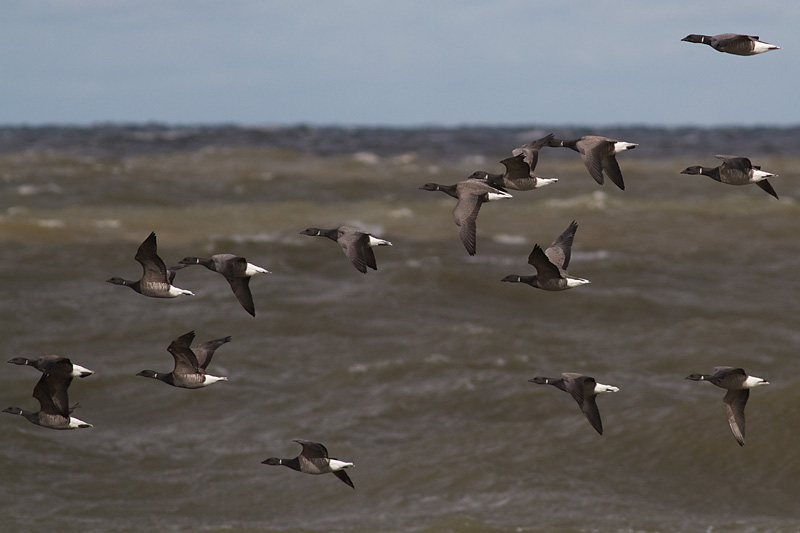
(4.) Kaikki ovat bernicloita. Muutamille alarivin linnuille valo osuu varsin voimakkaasti vatsapuolelle ja paljastaa melko selvät värirajat.
(4.) All bernicla. The sun hits quite strongly to underparts of some individuals here, and makes the contrast look strong.
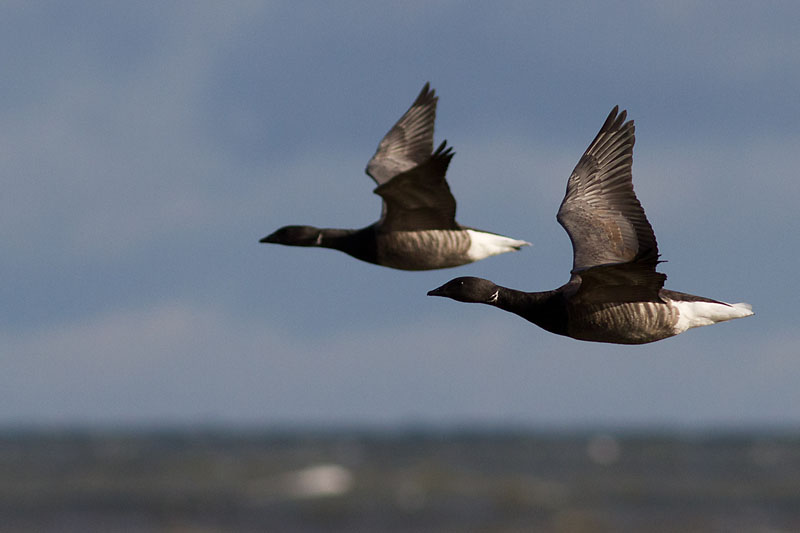
(5.) Kaksi berniclaa, joiden vatsa on osittain varjossa osittain auringossa. Sama tilanne tulee vastaan maastossakin.
(5.) Two berniclas which have underparts partly in shade, partly in sirect sunlight.
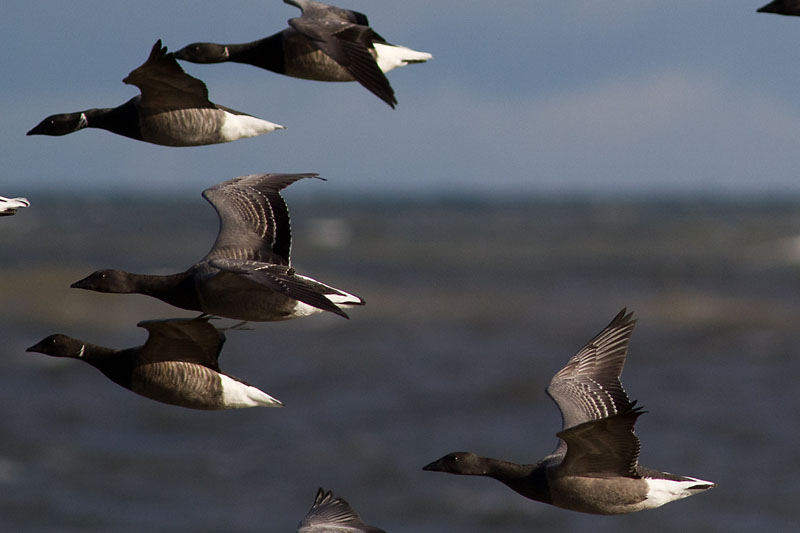
(6.) Alhaalla oikealla nuori bernicla, jonka tasaisen harmaa kylki saattaa näyttää kauemmas vaaleammalta kuin auikuisen juovikas kylki
(6.) Below right a young bernicla, in which the plain flanks may look paler than barred flanks of adults from longer distances.